PSY 101 - Memory Research: Paper vs. Digital Learning Impact
VerifiedAdded on 2022/09/29
|8
|1824
|32
Report
AI Summary
This research report investigates the impact of digital versus paper learning environments on student memory and performance. The study, conducted with 357 participants from a PSY 101 class, compared two groups: one using a screen-based digital learning environment and the other using paper-based materials. The research aimed to determine which learning method led to better information retention. The results indicated that students in the paper learning condition achieved a higher average test score compared to those in the digital learning condition, suggesting that paper-based learning may be more effective for memory and concept delivery. The report includes a detailed analysis of the methodology, results, and a discussion of the findings, with limitations acknowledged and recommendations for future research. The study highlights the potential benefits of traditional paper-based learning in an increasingly digital educational landscape.
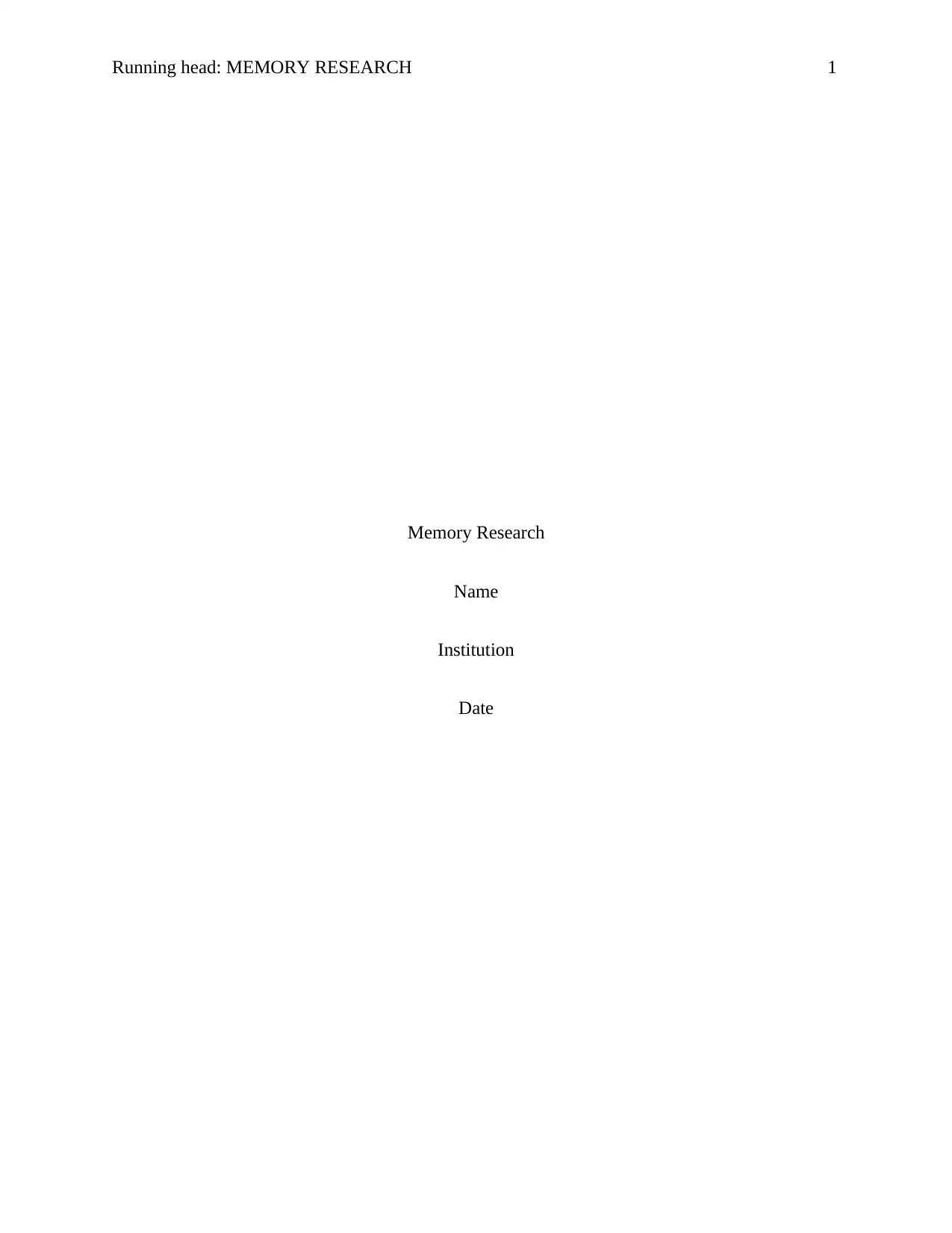
Running head: MEMORY RESEARCH 1
Memory Research
Name
Institution
Date
Memory Research
Name
Institution
Date
Paraphrase This Document
Need a fresh take? Get an instant paraphrase of this document with our AI Paraphraser
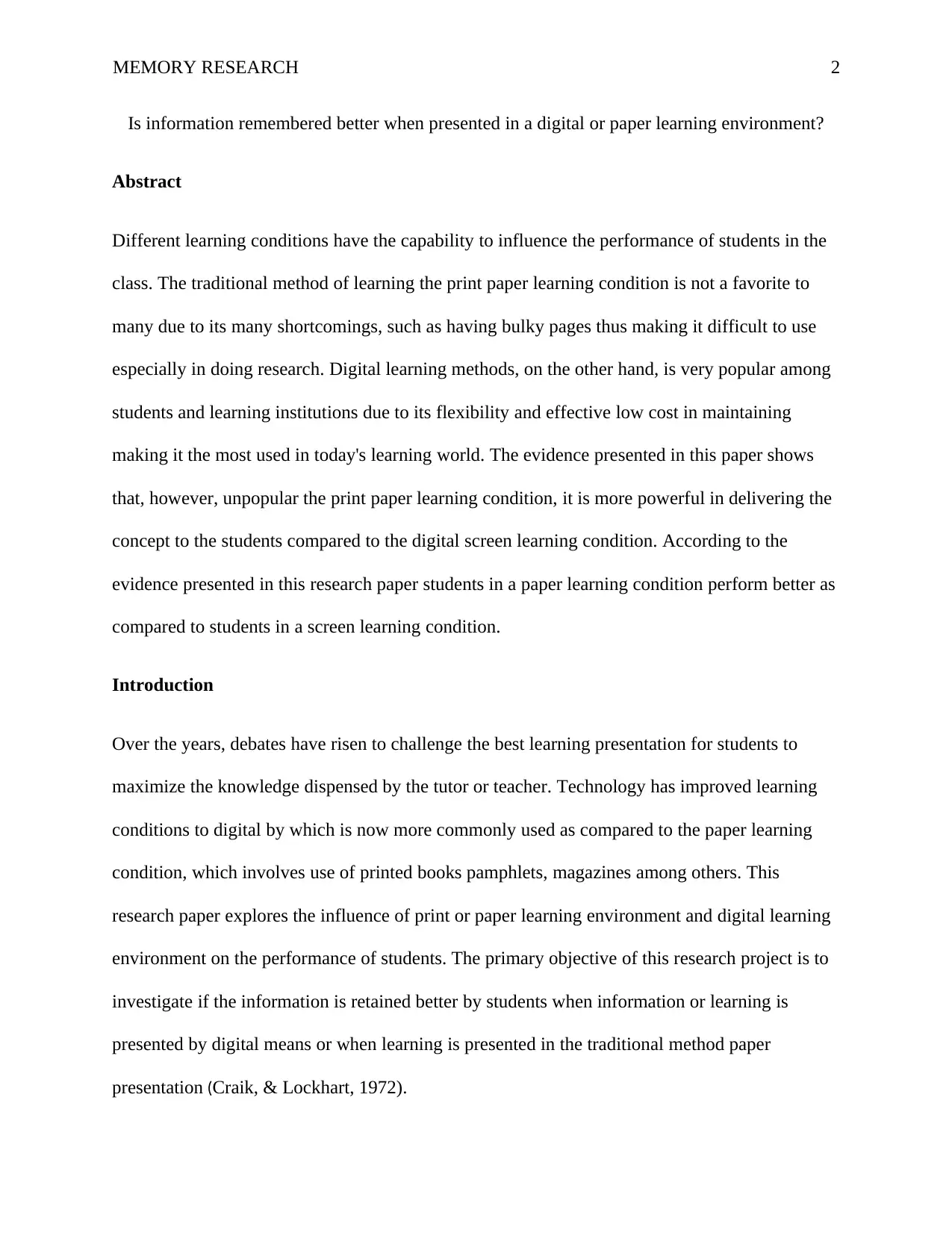
MEMORY RESEARCH 2
Is information remembered better when presented in a digital or paper learning environment?
Abstract
Different learning conditions have the capability to influence the performance of students in the
class. The traditional method of learning the print paper learning condition is not a favorite to
many due to its many shortcomings, such as having bulky pages thus making it difficult to use
especially in doing research. Digital learning methods, on the other hand, is very popular among
students and learning institutions due to its flexibility and effective low cost in maintaining
making it the most used in today's learning world. The evidence presented in this paper shows
that, however, unpopular the print paper learning condition, it is more powerful in delivering the
concept to the students compared to the digital screen learning condition. According to the
evidence presented in this research paper students in a paper learning condition perform better as
compared to students in a screen learning condition.
Introduction
Over the years, debates have risen to challenge the best learning presentation for students to
maximize the knowledge dispensed by the tutor or teacher. Technology has improved learning
conditions to digital by which is now more commonly used as compared to the paper learning
condition, which involves use of printed books pamphlets, magazines among others. This
research paper explores the influence of print or paper learning environment and digital learning
environment on the performance of students. The primary objective of this research project is to
investigate if the information is retained better by students when information or learning is
presented by digital means or when learning is presented in the traditional method paper
presentation (Craik, & Lockhart, 1972).
Is information remembered better when presented in a digital or paper learning environment?
Abstract
Different learning conditions have the capability to influence the performance of students in the
class. The traditional method of learning the print paper learning condition is not a favorite to
many due to its many shortcomings, such as having bulky pages thus making it difficult to use
especially in doing research. Digital learning methods, on the other hand, is very popular among
students and learning institutions due to its flexibility and effective low cost in maintaining
making it the most used in today's learning world. The evidence presented in this paper shows
that, however, unpopular the print paper learning condition, it is more powerful in delivering the
concept to the students compared to the digital screen learning condition. According to the
evidence presented in this research paper students in a paper learning condition perform better as
compared to students in a screen learning condition.
Introduction
Over the years, debates have risen to challenge the best learning presentation for students to
maximize the knowledge dispensed by the tutor or teacher. Technology has improved learning
conditions to digital by which is now more commonly used as compared to the paper learning
condition, which involves use of printed books pamphlets, magazines among others. This
research paper explores the influence of print or paper learning environment and digital learning
environment on the performance of students. The primary objective of this research project is to
investigate if the information is retained better by students when information or learning is
presented by digital means or when learning is presented in the traditional method paper
presentation (Craik, & Lockhart, 1972).
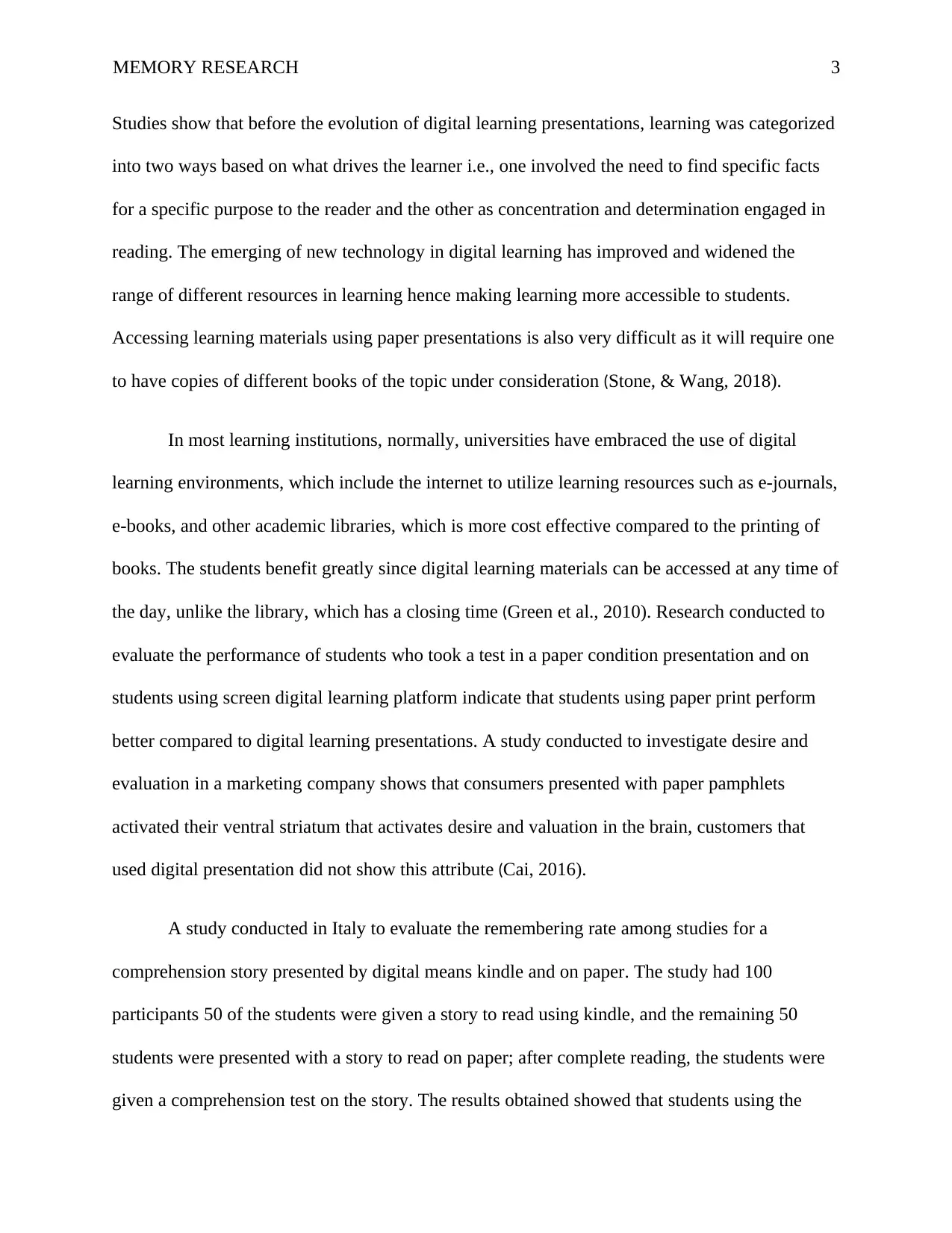
MEMORY RESEARCH 3
Studies show that before the evolution of digital learning presentations, learning was categorized
into two ways based on what drives the learner i.e., one involved the need to find specific facts
for a specific purpose to the reader and the other as concentration and determination engaged in
reading. The emerging of new technology in digital learning has improved and widened the
range of different resources in learning hence making learning more accessible to students.
Accessing learning materials using paper presentations is also very difficult as it will require one
to have copies of different books of the topic under consideration (Stone, & Wang, 2018).
In most learning institutions, normally, universities have embraced the use of digital
learning environments, which include the internet to utilize learning resources such as e-journals,
e-books, and other academic libraries, which is more cost effective compared to the printing of
books. The students benefit greatly since digital learning materials can be accessed at any time of
the day, unlike the library, which has a closing time (Green et al., 2010). Research conducted to
evaluate the performance of students who took a test in a paper condition presentation and on
students using screen digital learning platform indicate that students using paper print perform
better compared to digital learning presentations. A study conducted to investigate desire and
evaluation in a marketing company shows that consumers presented with paper pamphlets
activated their ventral striatum that activates desire and valuation in the brain, customers that
used digital presentation did not show this attribute (Cai, 2016).
A study conducted in Italy to evaluate the remembering rate among studies for a
comprehension story presented by digital means kindle and on paper. The study had 100
participants 50 of the students were given a story to read using kindle, and the remaining 50
students were presented with a story to read on paper; after complete reading, the students were
given a comprehension test on the story. The results obtained showed that students using the
Studies show that before the evolution of digital learning presentations, learning was categorized
into two ways based on what drives the learner i.e., one involved the need to find specific facts
for a specific purpose to the reader and the other as concentration and determination engaged in
reading. The emerging of new technology in digital learning has improved and widened the
range of different resources in learning hence making learning more accessible to students.
Accessing learning materials using paper presentations is also very difficult as it will require one
to have copies of different books of the topic under consideration (Stone, & Wang, 2018).
In most learning institutions, normally, universities have embraced the use of digital
learning environments, which include the internet to utilize learning resources such as e-journals,
e-books, and other academic libraries, which is more cost effective compared to the printing of
books. The students benefit greatly since digital learning materials can be accessed at any time of
the day, unlike the library, which has a closing time (Green et al., 2010). Research conducted to
evaluate the performance of students who took a test in a paper condition presentation and on
students using screen digital learning platform indicate that students using paper print perform
better compared to digital learning presentations. A study conducted to investigate desire and
evaluation in a marketing company shows that consumers presented with paper pamphlets
activated their ventral striatum that activates desire and valuation in the brain, customers that
used digital presentation did not show this attribute (Cai, 2016).
A study conducted in Italy to evaluate the remembering rate among studies for a
comprehension story presented by digital means kindle and on paper. The study had 100
participants 50 of the students were given a story to read using kindle, and the remaining 50
students were presented with a story to read on paper; after complete reading, the students were
given a comprehension test on the story. The results obtained showed that students using the
⊘ This is a preview!⊘
Do you want full access?
Subscribe today to unlock all pages.

Trusted by 1+ million students worldwide
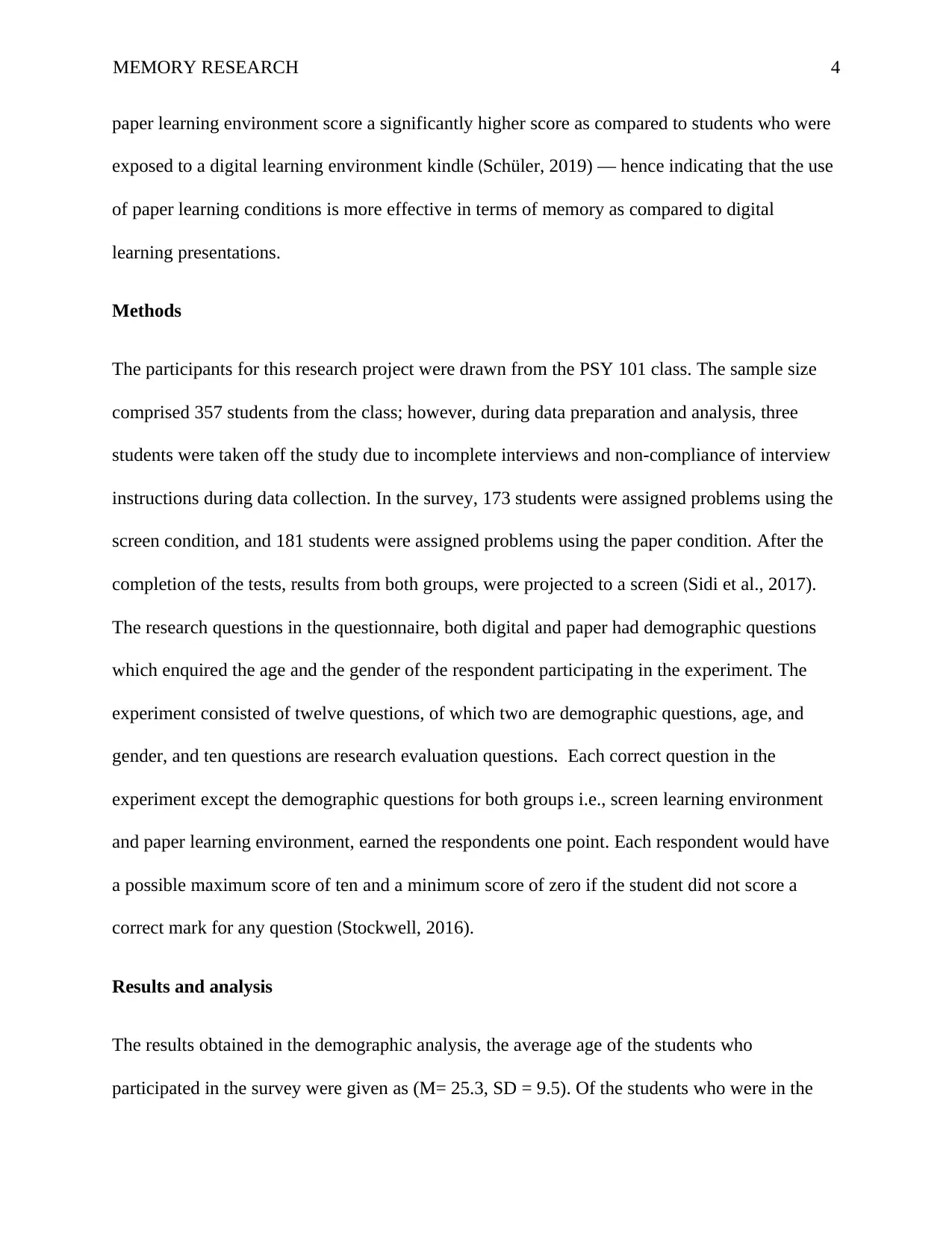
MEMORY RESEARCH 4
paper learning environment score a significantly higher score as compared to students who were
exposed to a digital learning environment kindle (Schüler, 2019) — hence indicating that the use
of paper learning conditions is more effective in terms of memory as compared to digital
learning presentations.
Methods
The participants for this research project were drawn from the PSY 101 class. The sample size
comprised 357 students from the class; however, during data preparation and analysis, three
students were taken off the study due to incomplete interviews and non-compliance of interview
instructions during data collection. In the survey, 173 students were assigned problems using the
screen condition, and 181 students were assigned problems using the paper condition. After the
completion of the tests, results from both groups, were projected to a screen (Sidi et al., 2017).
The research questions in the questionnaire, both digital and paper had demographic questions
which enquired the age and the gender of the respondent participating in the experiment. The
experiment consisted of twelve questions, of which two are demographic questions, age, and
gender, and ten questions are research evaluation questions. Each correct question in the
experiment except the demographic questions for both groups i.e., screen learning environment
and paper learning environment, earned the respondents one point. Each respondent would have
a possible maximum score of ten and a minimum score of zero if the student did not score a
correct mark for any question (Stockwell, 2016).
Results and analysis
The results obtained in the demographic analysis, the average age of the students who
participated in the survey were given as (M= 25.3, SD = 9.5). Of the students who were in the
paper learning environment score a significantly higher score as compared to students who were
exposed to a digital learning environment kindle (Schüler, 2019) — hence indicating that the use
of paper learning conditions is more effective in terms of memory as compared to digital
learning presentations.
Methods
The participants for this research project were drawn from the PSY 101 class. The sample size
comprised 357 students from the class; however, during data preparation and analysis, three
students were taken off the study due to incomplete interviews and non-compliance of interview
instructions during data collection. In the survey, 173 students were assigned problems using the
screen condition, and 181 students were assigned problems using the paper condition. After the
completion of the tests, results from both groups, were projected to a screen (Sidi et al., 2017).
The research questions in the questionnaire, both digital and paper had demographic questions
which enquired the age and the gender of the respondent participating in the experiment. The
experiment consisted of twelve questions, of which two are demographic questions, age, and
gender, and ten questions are research evaluation questions. Each correct question in the
experiment except the demographic questions for both groups i.e., screen learning environment
and paper learning environment, earned the respondents one point. Each respondent would have
a possible maximum score of ten and a minimum score of zero if the student did not score a
correct mark for any question (Stockwell, 2016).
Results and analysis
The results obtained in the demographic analysis, the average age of the students who
participated in the survey were given as (M= 25.3, SD = 9.5). Of the students who were in the
Paraphrase This Document
Need a fresh take? Get an instant paraphrase of this document with our AI Paraphraser
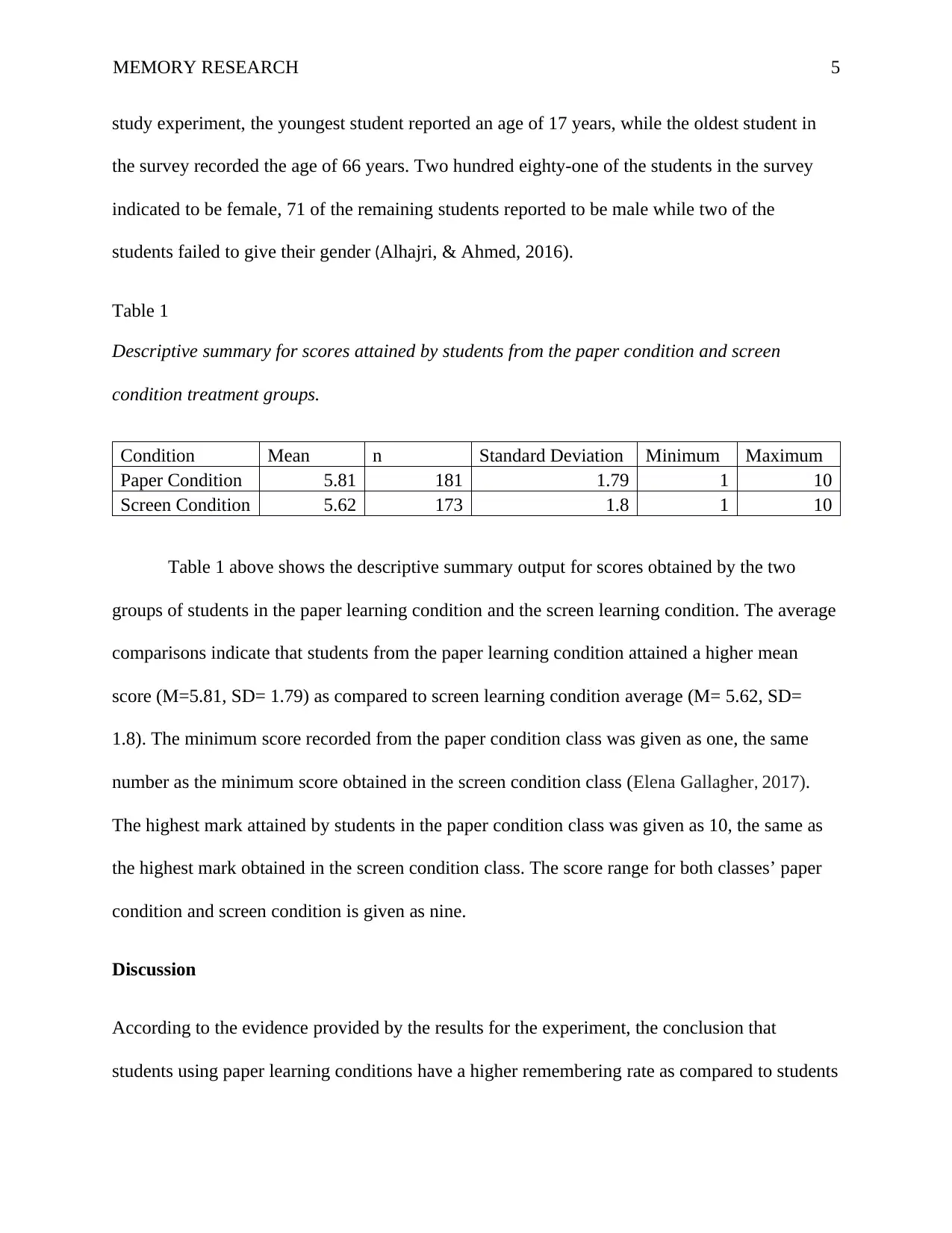
MEMORY RESEARCH 5
study experiment, the youngest student reported an age of 17 years, while the oldest student in
the survey recorded the age of 66 years. Two hundred eighty-one of the students in the survey
indicated to be female, 71 of the remaining students reported to be male while two of the
students failed to give their gender (Alhajri, & Ahmed, 2016).
Table 1
Descriptive summary for scores attained by students from the paper condition and screen
condition treatment groups.
Condition Mean n Standard Deviation Minimum Maximum
Paper Condition 5.81 181 1.79 1 10
Screen Condition 5.62 173 1.8 1 10
Table 1 above shows the descriptive summary output for scores obtained by the two
groups of students in the paper learning condition and the screen learning condition. The average
comparisons indicate that students from the paper learning condition attained a higher mean
score (M=5.81, SD= 1.79) as compared to screen learning condition average (M= 5.62, SD=
1.8). The minimum score recorded from the paper condition class was given as one, the same
number as the minimum score obtained in the screen condition class (Elena Gallagher, 2017).
The highest mark attained by students in the paper condition class was given as 10, the same as
the highest mark obtained in the screen condition class. The score range for both classes’ paper
condition and screen condition is given as nine.
Discussion
According to the evidence provided by the results for the experiment, the conclusion that
students using paper learning conditions have a higher remembering rate as compared to students
study experiment, the youngest student reported an age of 17 years, while the oldest student in
the survey recorded the age of 66 years. Two hundred eighty-one of the students in the survey
indicated to be female, 71 of the remaining students reported to be male while two of the
students failed to give their gender (Alhajri, & Ahmed, 2016).
Table 1
Descriptive summary for scores attained by students from the paper condition and screen
condition treatment groups.
Condition Mean n Standard Deviation Minimum Maximum
Paper Condition 5.81 181 1.79 1 10
Screen Condition 5.62 173 1.8 1 10
Table 1 above shows the descriptive summary output for scores obtained by the two
groups of students in the paper learning condition and the screen learning condition. The average
comparisons indicate that students from the paper learning condition attained a higher mean
score (M=5.81, SD= 1.79) as compared to screen learning condition average (M= 5.62, SD=
1.8). The minimum score recorded from the paper condition class was given as one, the same
number as the minimum score obtained in the screen condition class (Elena Gallagher, 2017).
The highest mark attained by students in the paper condition class was given as 10, the same as
the highest mark obtained in the screen condition class. The score range for both classes’ paper
condition and screen condition is given as nine.
Discussion
According to the evidence provided by the results for the experiment, the conclusion that
students using paper learning conditions have a higher remembering rate as compared to students
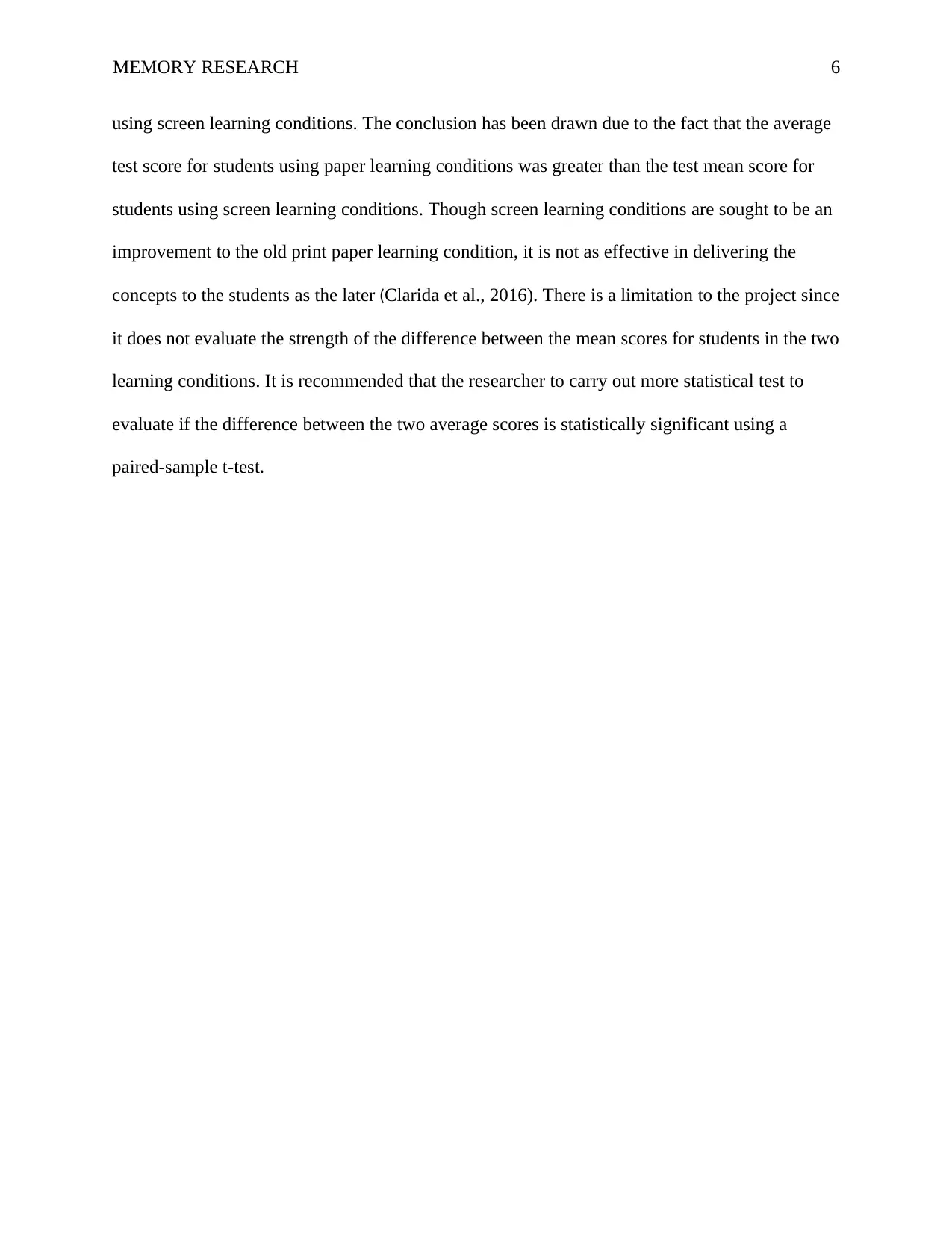
MEMORY RESEARCH 6
using screen learning conditions. The conclusion has been drawn due to the fact that the average
test score for students using paper learning conditions was greater than the test mean score for
students using screen learning conditions. Though screen learning conditions are sought to be an
improvement to the old print paper learning condition, it is not as effective in delivering the
concepts to the students as the later (Clarida et al., 2016). There is a limitation to the project since
it does not evaluate the strength of the difference between the mean scores for students in the two
learning conditions. It is recommended that the researcher to carry out more statistical test to
evaluate if the difference between the two average scores is statistically significant using a
paired-sample t-test.
using screen learning conditions. The conclusion has been drawn due to the fact that the average
test score for students using paper learning conditions was greater than the test mean score for
students using screen learning conditions. Though screen learning conditions are sought to be an
improvement to the old print paper learning condition, it is not as effective in delivering the
concepts to the students as the later (Clarida et al., 2016). There is a limitation to the project since
it does not evaluate the strength of the difference between the mean scores for students in the two
learning conditions. It is recommended that the researcher to carry out more statistical test to
evaluate if the difference between the two average scores is statistically significant using a
paired-sample t-test.
⊘ This is a preview!⊘
Do you want full access?
Subscribe today to unlock all pages.

Trusted by 1+ million students worldwide
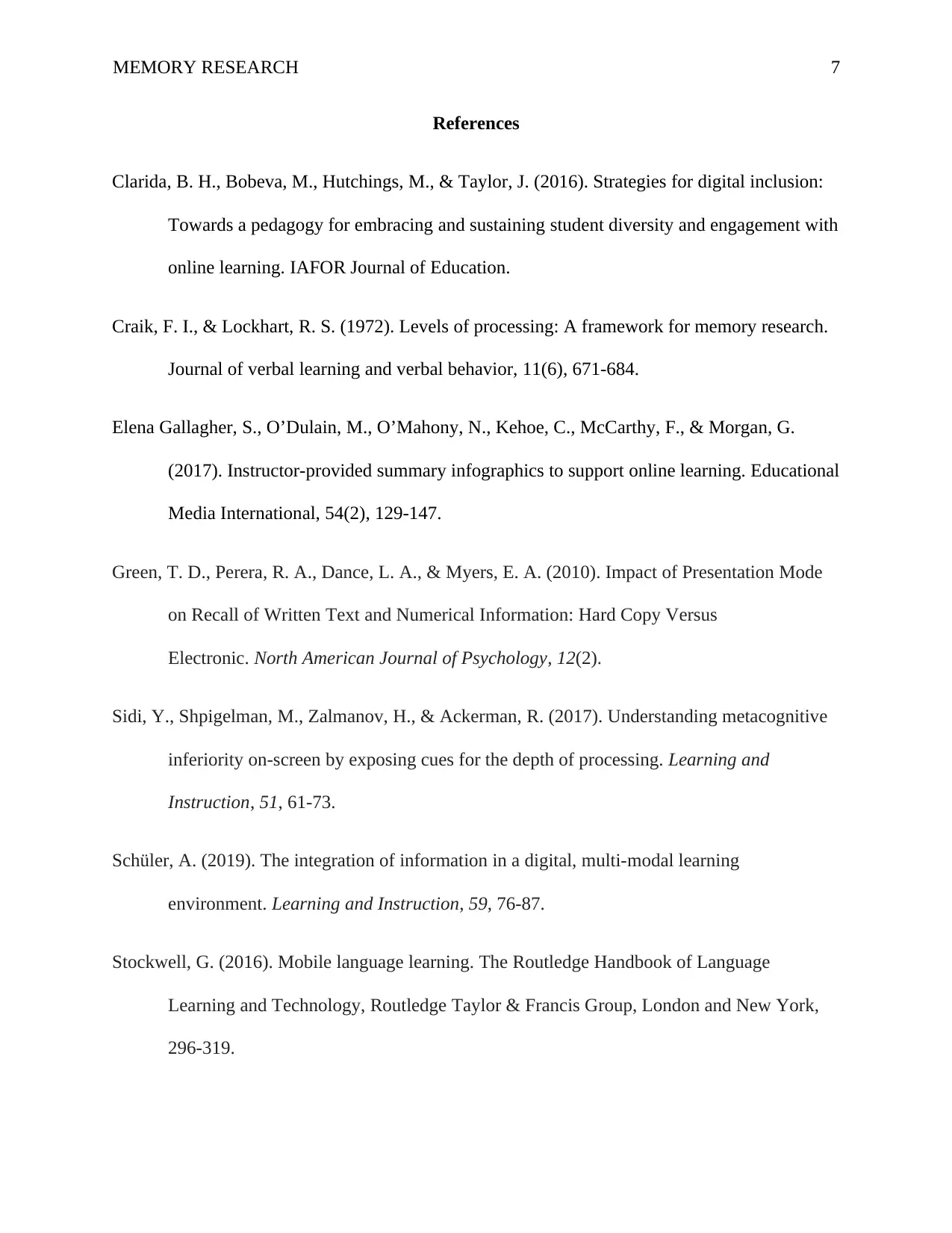
MEMORY RESEARCH 7
References
Clarida, B. H., Bobeva, M., Hutchings, M., & Taylor, J. (2016). Strategies for digital inclusion:
Towards a pedagogy for embracing and sustaining student diversity and engagement with
online learning. IAFOR Journal of Education.
Craik, F. I., & Lockhart, R. S. (1972). Levels of processing: A framework for memory research.
Journal of verbal learning and verbal behavior, 11(6), 671-684.
Elena Gallagher, S., O’Dulain, M., O’Mahony, N., Kehoe, C., McCarthy, F., & Morgan, G.
(2017). Instructor-provided summary infographics to support online learning. Educational
Media International, 54(2), 129-147.
Green, T. D., Perera, R. A., Dance, L. A., & Myers, E. A. (2010). Impact of Presentation Mode
on Recall of Written Text and Numerical Information: Hard Copy Versus
Electronic. North American Journal of Psychology, 12(2).
Sidi, Y., Shpigelman, M., Zalmanov, H., & Ackerman, R. (2017). Understanding metacognitive
inferiority on-screen by exposing cues for the depth of processing. Learning and
Instruction, 51, 61-73.
Schüler, A. (2019). The integration of information in a digital, multi-modal learning
environment. Learning and Instruction, 59, 76-87.
Stockwell, G. (2016). Mobile language learning. The Routledge Handbook of Language
Learning and Technology, Routledge Taylor & Francis Group, London and New York,
296-319.
References
Clarida, B. H., Bobeva, M., Hutchings, M., & Taylor, J. (2016). Strategies for digital inclusion:
Towards a pedagogy for embracing and sustaining student diversity and engagement with
online learning. IAFOR Journal of Education.
Craik, F. I., & Lockhart, R. S. (1972). Levels of processing: A framework for memory research.
Journal of verbal learning and verbal behavior, 11(6), 671-684.
Elena Gallagher, S., O’Dulain, M., O’Mahony, N., Kehoe, C., McCarthy, F., & Morgan, G.
(2017). Instructor-provided summary infographics to support online learning. Educational
Media International, 54(2), 129-147.
Green, T. D., Perera, R. A., Dance, L. A., & Myers, E. A. (2010). Impact of Presentation Mode
on Recall of Written Text and Numerical Information: Hard Copy Versus
Electronic. North American Journal of Psychology, 12(2).
Sidi, Y., Shpigelman, M., Zalmanov, H., & Ackerman, R. (2017). Understanding metacognitive
inferiority on-screen by exposing cues for the depth of processing. Learning and
Instruction, 51, 61-73.
Schüler, A. (2019). The integration of information in a digital, multi-modal learning
environment. Learning and Instruction, 59, 76-87.
Stockwell, G. (2016). Mobile language learning. The Routledge Handbook of Language
Learning and Technology, Routledge Taylor & Francis Group, London and New York,
296-319.
Paraphrase This Document
Need a fresh take? Get an instant paraphrase of this document with our AI Paraphraser
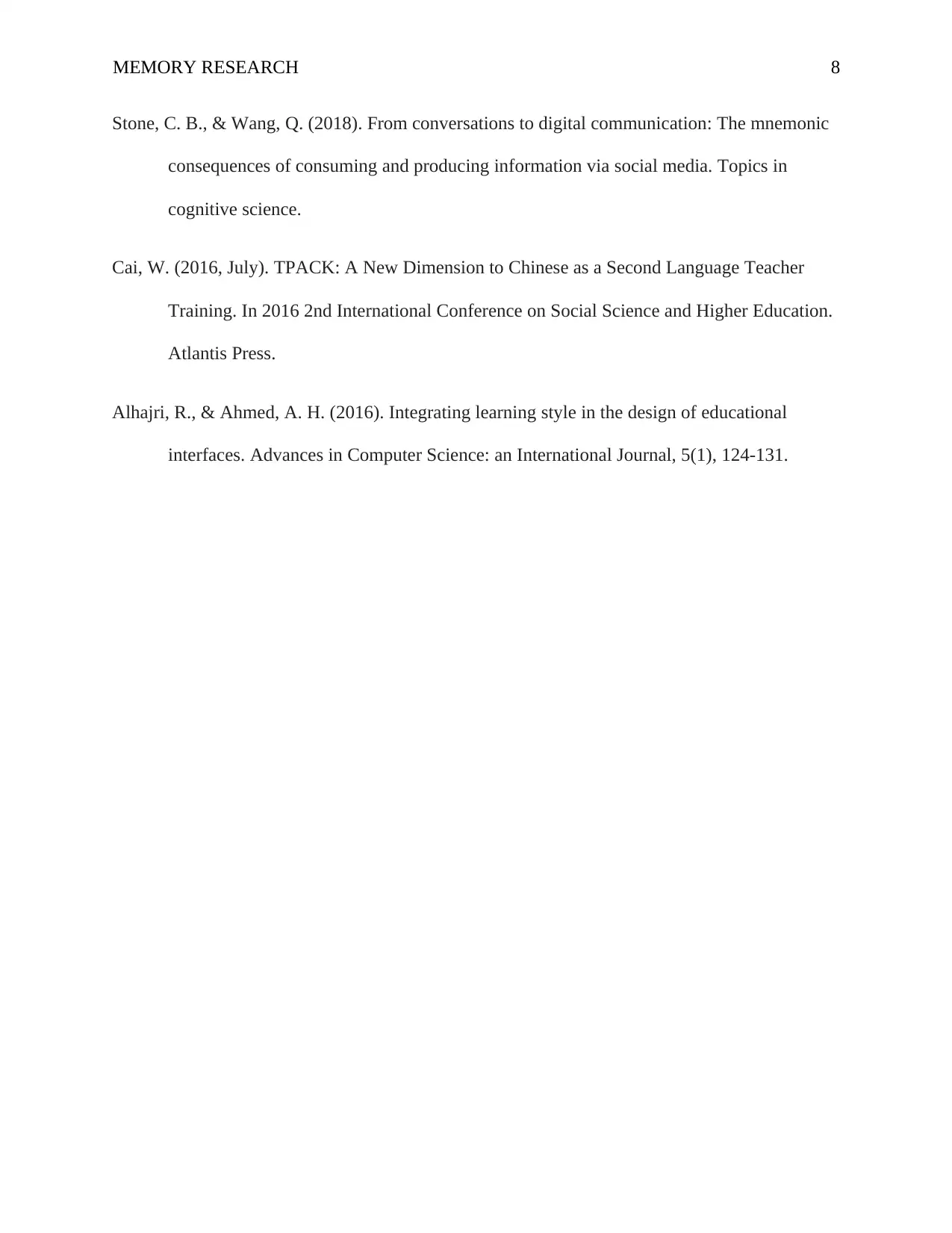
MEMORY RESEARCH 8
Stone, C. B., & Wang, Q. (2018). From conversations to digital communication: The mnemonic
consequences of consuming and producing information via social media. Topics in
cognitive science.
Cai, W. (2016, July). TPACK: A New Dimension to Chinese as a Second Language Teacher
Training. In 2016 2nd International Conference on Social Science and Higher Education.
Atlantis Press.
Alhajri, R., & Ahmed, A. H. (2016). Integrating learning style in the design of educational
interfaces. Advances in Computer Science: an International Journal, 5(1), 124-131.
Stone, C. B., & Wang, Q. (2018). From conversations to digital communication: The mnemonic
consequences of consuming and producing information via social media. Topics in
cognitive science.
Cai, W. (2016, July). TPACK: A New Dimension to Chinese as a Second Language Teacher
Training. In 2016 2nd International Conference on Social Science and Higher Education.
Atlantis Press.
Alhajri, R., & Ahmed, A. H. (2016). Integrating learning style in the design of educational
interfaces. Advances in Computer Science: an International Journal, 5(1), 124-131.
1 out of 8
Related Documents
Your All-in-One AI-Powered Toolkit for Academic Success.
+13062052269
info@desklib.com
Available 24*7 on WhatsApp / Email
![[object Object]](/_next/static/media/star-bottom.7253800d.svg)
Unlock your academic potential
Copyright © 2020–2025 A2Z Services. All Rights Reserved. Developed and managed by ZUCOL.





